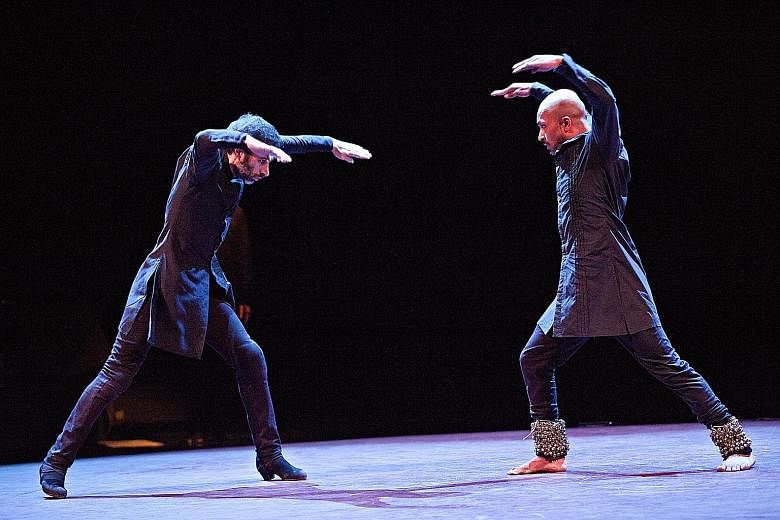British dancer-choreographer Akram Khan wooed ballet superstar Sylvie Guillem for a dance collaboration, Sacred Monsters, nearly 10 years ago that was at once cheeky and cutting-edge.
The award-winning Khan, who has reinvented the classical Indian dance kathak in his own formidable way, was all angles and stamping feet; Guillem was fluid and light on her toes.
This year, he is returning here with another collaboration - this time, a testosterone-fuelled duet called Torobaka (meaning bull- cow). He joins forces with another reinventor of a classic genre, Spanish flamenco artist Israel Galvan.
Will Torobaka continue in that same vein of mischievous give-and- take?
"Oh, Sacred Monsters was much, much more polite. I wouldn't call this polite," Khan, 41, says with a chuckle. He is in a taxi in London, shuttling between his office and then to the airport for a performance of Torobaka in Germany.
-
BOOK IT / TOROBAKA
-
WHERE: Esplanade Theatre
WHEN: Oct 16 and 17, 8pm
ADMISSION: $20 to $100 from Sistic (excludes booking fee; call 6348-5555 or go to www.sistic.com.sg)
"If you can imagine this - we tried to imagine it, so - it's a little bit like if Stanley Kubrick did kathak and David Lynch did flamenco. What would that conversation be like, if they had a collaboration?"
So more of a duel than a duet, perhaps. Khan insists that when Galvan swept into the rehearsal studio, "he was coming in to kill me. He wanted to kill the competition".
Khan, who is of Bangladeshi descent, believes it is Galvan's first collaboration with a dancer from another genre and they were initially "nervous and tense" around each other.
Khan says: "I was afraid that there was fear and he was afraid because we were dancing together, and so there was a kind of violent warrior in him and a peaceful monk in me."
Galvan, 42, says that while kathak is "very mathematical" in rhythm, "flamenco is more free in its structure". He says over e-mail: "Akram said to me that when you dance kathak, you're making a gift to the audience, while in flamenco, it feels more like a war, you have to kill the audience before the audience kills you."
Despite that initial rivalry ("I can't compete with him," Khan protests) and a language barrier (Khan does not speak Spanish and Galvan does not speak English), a strong friendship blossomed between the two dancers. They started creating the work in 2013 after a mutual friend "whispered into our ears" that it might be "interesting" to collaborate.
Khan had little interest in matching kathak with flamenco prior to this encounter because he had seen mash-ups that were "a little bit superficial" in terms of their movement vocabulary.
But the moment he saw Galvan on stage, he was hooked: "He was blurring the lines between what one expects to be right and what is wrong. He's an incredible dancer and performer, a real master of his form - he's taken the form and made it his form."
This is not the first time that kathak and flamenco have bedded each other. Both forms go back to the trade routes between India and Spain in the 11th century and the Romany people who travelled between the two countries. One might notice similar tropes - the proud, upright carriage; the intricate footwork; the complex rhythms.
Khan and Galvan rehearsed with translators in the room, but found they could communicate in other ways. They share the stage with with four musicians who hail from both cultures.
Khan says: "We realised that if we go back to the roots of it, our bodies are instruments. The bodies are also a language. We communicated a lot through rhythmical structures and patterns, and a lot of the time, you didn't have to speak about it. You just showed it physically and verbally."
Working with someone from a different culture has been edifying in the way Khan sees himself. "What's interesting when I collaborate with another artist is that I try it to see what I do from his perspective," he says.
And through Galvan, he discovered his "stillness", which was surprising to him.
Khan says: "I don't like to be still very often and I'm quite fast. It was quite strange when Israel found me to be quite still. He thought I was Gandhi. And I don't really know if I should take that as a compliment?
"Because I wore his friend's glasses, I think, one of the musicians, and they were circular glasses, and he said, 'Ah! You are Gandhi. You are Gandhi on stage. You are the peaceful warrior.'"
Galvan says: "Now I feel much more relieved... I am much less anxious when facing the audience. Akram was kind of a spiritual healer for me."
Khan has also been trying to keep up with the changes to his own body. Three years ago, he suffered a tear to his Achilles' tendon that could have spelt the end of his career. His Olivier Award-winning solo dance piece Desh, set to take the stage at the 2012 Singapore Arts Festival, was pulled from the line- up. While he has recovered from that setback, he is not taking his body's warnings lightly.
He says: "Your body's saying, 'Hey, I've got a voice now. You've ignored me for the first 30 years, now you're going to listen to me and I'm going to tell you what I don't like you doing.'"
He says while he will continue to keep fit and maintain his connection to the stage, he will be winding down performing full-length pieces in the next few years and it is unlikely that he will "go till 50".
But "it's not all doom and gloom", he adds. "You become more intelligent. It's not all about athleticism. That's what's so beautiful about dance. Dance is about communicating something with your body. Your spirit doesn't grow old."


